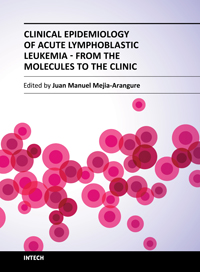Reference type: Book
Author:
Roman Crazzolara, Adrian Kneer, Bernhard Meister and Gabriele Kropshofer
Year published: 2013

Abstract:
The success rate of acute lymphoblastic leukemia (ALL) therapy has gradually increased over the past decades. With more than 80% long-term survivors, treatment of ALL in children is undoubtedly one of the great success stories of innovative study-controlled modern medicine[1]. Attempts to boost cure rates for those who do not respond to therapy or relapse with more intense chemotherapy including allogeneic hematopoietic stem cell transplantation havefurther improved the outcome of patients, particularly for prognostic unfavorable subgroups[2]. However, intensification of treatment can substantially increase morbidity, the risk for life-threatening sequelae and mortality [1].Several studies address this important issue and report on the emergence of fungi. A retrospective review of ~ 5.600 patients who underwent hematopoietic stem cell transplantation at the Fred Hutchinson Cancer Research Center (Seattle) from 1985 to 1999 reports a constant increase of 3.5% in the one-year cumulative incidence of probable and proven invasive fungal infections [3]. Investigation of autopsies, skin, and lung biopsies, and bronchoalveolar lavage fluid analyses reveal that non-fumigatus Aspergillus species, such as Fusarium and Zygomycetes have increased, especially in patients, who have received multiple transplants. These observations are particular worrisome given the increasing importance of amphothericin-B resistant organisms, resulting in a very poor one-year survival rate of ~ 20% [4]. For those who do survive, length of hospital stay and total hospital charges are increased, compared withimmunocompromised patients without fungal infection [5].Despite much effort has been taken to improve therapeutic treatments and strategies, therestill remains much uncertainty and controversy regarding the best method to diagnose,prevent and treat fungal infections [6]. Practicing physicians approach this uncertainty bytreating suspected infections empirically. However, researchers that conduct clinical trials tend to accept only cases in which the diagnosis is certain in order to improve clarity and uniformityof clinical trials. Therefore, members of the European Organization for Research and Treatment of Cancer / Invasive Fungal Infection Study Group (EORTC) and the National Institute of Allergy and Infectious Disease (NIAID) Mycoses Study Group (MSG) formed a consensus study group to define standard definitions of invasive fungal infections for clinical research[7]. Practice guidelines are intended to limit practice variations towards movements such as evidence-based medicine and are primarily suggested by the European Conference of Infections in Leukemia (ECIL; http://www.ebmt.org/Contents/Resources/Library/ ECIL/Pages/ECIL.aspx). For the clinical purpose there is still a need to develop more effective prevention and treatment strategies. Such strategies may rely on newer antifungal agents that are active against amphothericin B resistant moulds and are well tolerated. Because of limited number of affected patients, multicenter collaborative trials are required.This case-based review examines the current literature to explore basic concepts on epidemiology, diagnosis and treatment of invasive fungal infections in ALL patients. A case report will be used to illustrate these specific issues.
URL: http://dx.doi.org/10.5772/54990
Open access book: https://www.aspergillus.org.uk/wp-content/uploads/2016/05/44069_0.pdf
